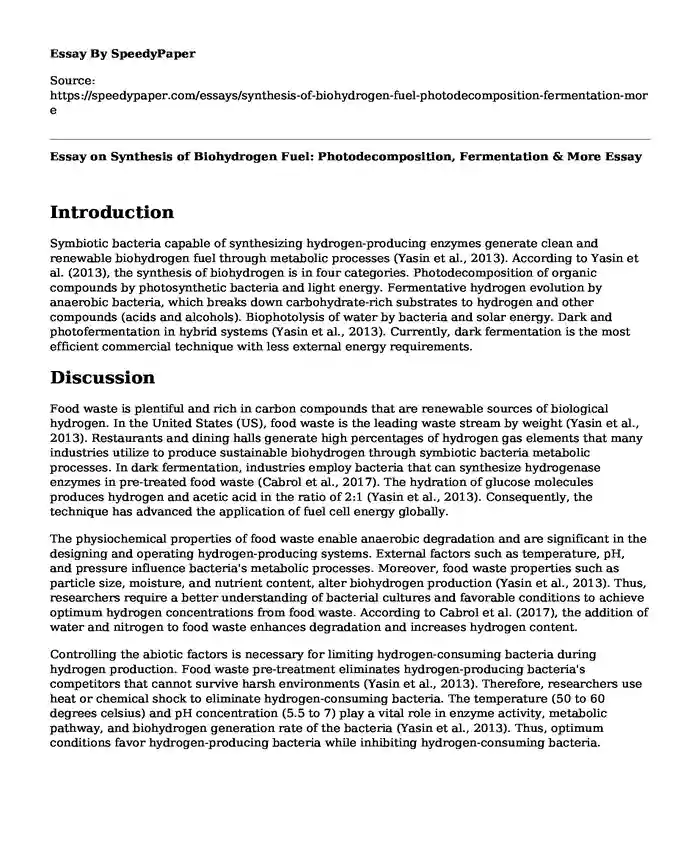Introduction
Symbiotic bacteria capable of synthesizing hydrogen-producing enzymes generate clean and renewable biohydrogen fuel through metabolic processes (Yasin et al., 2013). According to Yasin et al. (2013), the synthesis of biohydrogen is in four categories. Photodecomposition of organic compounds by photosynthetic bacteria and light energy. Fermentative hydrogen evolution by anaerobic bacteria, which breaks down carbohydrate-rich substrates to hydrogen and other compounds (acids and alcohols). Biophotolysis of water by bacteria and solar energy. Dark and photofermentation in hybrid systems (Yasin et al., 2013). Currently, dark fermentation is the most efficient commercial technique with less external energy requirements.
Discussion
Food waste is plentiful and rich in carbon compounds that are renewable sources of biological hydrogen. In the United States (US), food waste is the leading waste stream by weight (Yasin et al., 2013). Restaurants and dining halls generate high percentages of hydrogen gas elements that many industries utilize to produce sustainable biohydrogen through symbiotic bacteria metabolic processes. In dark fermentation, industries employ bacteria that can synthesize hydrogenase enzymes in pre-treated food waste (Cabrol et al., 2017). The hydration of glucose molecules produces hydrogen and acetic acid in the ratio of 2:1 (Yasin et al., 2013). Consequently, the technique has advanced the application of fuel cell energy globally.
The physiochemical properties of food waste enable anaerobic degradation and are significant in the designing and operating hydrogen-producing systems. External factors such as temperature, pH, and pressure influence bacteria's metabolic processes. Moreover, food waste properties such as particle size, moisture, and nutrient content, alter biohydrogen production (Yasin et al., 2013). Thus, researchers require a better understanding of bacterial cultures and favorable conditions to achieve optimum hydrogen concentrations from food waste. According to Cabrol et al. (2017), the addition of water and nitrogen to food waste enhances degradation and increases hydrogen content.
Controlling the abiotic factors is necessary for limiting hydrogen-consuming bacteria during hydrogen production. Food waste pre-treatment eliminates hydrogen-producing bacteria's competitors that cannot survive harsh environments (Yasin et al., 2013). Therefore, researchers use heat or chemical shock to eliminate hydrogen-consuming bacteria. The temperature (50 to 60 degrees celsius) and pH concentration (5.5 to 7) play a vital role in enzyme activity, metabolic pathway, and biohydrogen generation rate of the bacteria (Yasin et al., 2013). Thus, optimum conditions favor hydrogen-producing bacteria while inhibiting hydrogen-consuming bacteria.
Impacts
The increase in the world's energy demands propelled the utilization of renewable sources such as food waste for biohydrogen production. The approach is a promising project that can replace fossil fuels and solve waste disposal problems worldwide. In 2011, The Star newspaper reported that Malaysia throws away up to 930 tons of food waste daily (Yasin et al., 2013). The organic leftovers present readily available sources for sustainable bioenergy. Therefore, the implementation of biohydrogen production systems can control the accumulation of food waste and generate clean, renewable fuels at a cheaper cost.
Future Recommendations
A large amount of unconsumed food goes to waste every day globally. With increasing energy demands, biohydrogen production from food waste can solve two major world problems. The efficient production of hydrogen through hybrid fermentation technology that combines photo-fermentation and dark fermentation ensures the generation of clean, renewable energy. Hydrogen fuel applications in the transportation and manufacturing industries will be cost-effective and environmentally friendly. Furthermore, efficient waste management practices also restore the health of the ecosystem.
Conclusion
Metabolic processes maintain the energy production rates in ecosystems, which is integral in the survival of biota. The symbiotic bacteria’s production of biohydrogen from food waste is one of the most economical techniques of generating clean, renewable fuel to meet the increasing world demand. With assured available resources, researchers have to take advantage to produce bioenergy while controlling waste accumulation worldwide.
References
Cabrol, L., Marone, A., Tapia-Venegas, E., Steyer, J. P., Ruiz-Filippi, G., & Trably, E. (2017). Microbial ecology of fermentative hydrogen producing bioprocesses: Useful insights for driving the ecosystem function. FEMS Microbiology Reviews, 41(2), 158-181.
Yasin, N. H. M., Mumtaz, T., & Hassan, M. A. (2013). Food waste and food processing waste for biohydrogen production: A review. Journal of Environmental Management, 130(10), 375-385.
Cite this page
Essay on Synthesis of Biohydrogen Fuel: Photodecomposition, Fermentation & More. (2023, Oct 27). Retrieved from https://speedypaper.com/essays/synthesis-of-biohydrogen-fuel-photodecomposition-fermentation-more
Request Removal
If you are the original author of this essay and no longer wish to have it published on the SpeedyPaper website, please click below to request its removal:
- Science Essay Example: Eukaryotic and Prokaryotic Cells
- Essay Example on the Greece World
- Essay Sample on How Are Z and T Confidence Intervals Different?
- Free Essay: What is the National Construction Code (NCC)?
- Paper Example. Evaluation of Randomized Control Study
- Essay on Analyzing Statistical Methods: A Critique of a Survey on Newspaper Readability in the Digital Age
- American Political Disputes - Essay Sample
Popular categories





